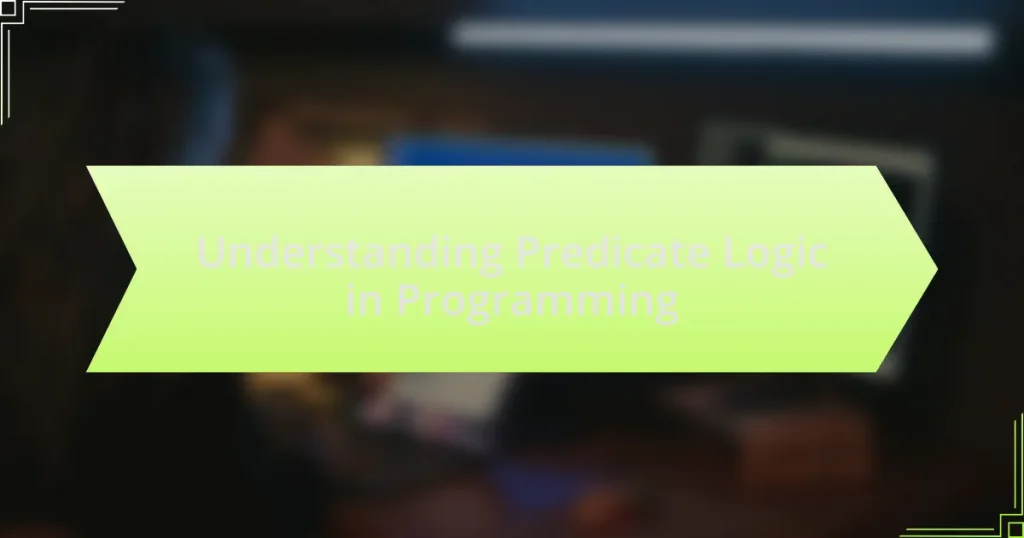Constraint Logic Programming (CLP) is a programming paradigm that merges constraint satisfaction with logic programming, allowing for the expression of complex problems in a declarative manner. This article explores the fundamental concepts of CLP, its key features, and how it differs from traditional logic programming. It also examines the role of constraints, the techniques used in CLP, and the various applications across fields such as artificial intelligence and operations research. Additionally, the article addresses challenges associated with CLP, best practices for implementation, and future trends in the field, providing a comprehensive overview of this advanced topic in logic programming.

What is Constraint Logic Programming?
Constraint Logic Programming (CLP) is a programming paradigm that combines the principles of constraint satisfaction with logic programming. In CLP, logic variables can be constrained by relations, allowing for the expression of complex problems in a declarative manner. This approach enables the solver to efficiently explore possible solutions by narrowing down the search space based on the constraints applied. CLP has been successfully applied in various domains, including scheduling, resource allocation, and combinatorial problems, demonstrating its effectiveness in solving real-world challenges.
How does Constraint Logic Programming differ from traditional logic programming?
Constraint Logic Programming (CLP) differs from traditional logic programming by integrating constraints into the logic programming paradigm, allowing for more expressive problem-solving capabilities. In traditional logic programming, such as Prolog, the focus is primarily on the logical relationships and rules, whereas CLP extends this by incorporating constraints that restrict the possible values of variables, enabling the handling of complex problems like scheduling and resource allocation more efficiently. This integration allows CLP to solve problems that are not easily addressed by traditional logic programming alone, as it can prune the search space based on the constraints provided, leading to more efficient computation and solutions.
What are the key features that define Constraint Logic Programming?
Constraint Logic Programming (CLP) is defined by its integration of constraint satisfaction problems with logic programming paradigms. Key features include the ability to express problems declaratively, the use of constraints to limit the search space, and the incorporation of both logical reasoning and constraint solving techniques. CLP allows for the specification of complex relationships and conditions, enabling efficient problem-solving in various domains such as scheduling, resource allocation, and combinatorial problems. The framework supports various types of constraints, including numerical, finite domain, and symbolic constraints, enhancing its versatility and applicability in real-world scenarios.
Why is Constraint Logic Programming considered an advanced topic?
Constraint Logic Programming is considered an advanced topic due to its integration of constraint satisfaction problems with logic programming paradigms. This approach allows for the expression of complex relationships and conditions within a logical framework, enabling more sophisticated problem-solving capabilities. The advanced nature is further evidenced by its applications in fields such as artificial intelligence, operations research, and scheduling, where it effectively handles combinatorial problems that traditional logic programming cannot efficiently solve.
What are the fundamental concepts of Constraint Logic Programming?
The fundamental concepts of Constraint Logic Programming (CLP) include the integration of constraints into logic programming, the use of constraint solvers, and the declarative nature of problem-solving. CLP extends traditional logic programming by allowing variables to be constrained by relations, enabling the expression of complex problems succinctly. Constraint solvers are algorithms that efficiently find solutions to these constraints, often used in optimization and scheduling problems. The declarative approach allows programmers to specify what the solution should satisfy rather than how to compute it, enhancing clarity and maintainability. These concepts are foundational in various applications, including artificial intelligence and operations research, demonstrating the versatility and power of CLP in solving real-world problems.
What role do constraints play in Constraint Logic Programming?
Constraints in Constraint Logic Programming (CLP) serve as conditions that restrict the possible values of variables, guiding the search for solutions. They enable the expression of relationships and conditions that must be satisfied, allowing for more efficient problem-solving by narrowing down the solution space. For instance, in a scheduling problem, constraints can specify that certain tasks cannot overlap, thus directly influencing the feasibility of potential solutions. This structured approach enhances the ability to model complex problems and derive solutions systematically, as evidenced by the successful application of CLP in fields such as scheduling, resource allocation, and combinatorial optimization.
How are variables and domains defined in this programming paradigm?
In Constraint Logic Programming (CLP), variables are defined as symbolic placeholders that can take on values from specified domains. Domains in CLP are sets of possible values that variables can assume, often constrained by specific conditions or relationships. For instance, in a typical CLP scenario, a variable representing an integer might have a domain defined as the range of integers between 1 and 10, which restricts its possible values to that range. This definition is crucial as it allows the programming paradigm to efficiently solve problems by narrowing down the search space based on the constraints applied to the variables.
What are the applications of Constraint Logic Programming?
Constraint Logic Programming (CLP) is applied in various domains such as scheduling, resource allocation, and configuration problems. In scheduling, CLP efficiently handles constraints to optimize time and resource usage, as seen in airline flight scheduling systems. In resource allocation, it aids in distributing limited resources among competing tasks while satisfying specific constraints, exemplified in project management tools. Additionally, CLP is utilized in configuration problems, where it helps in designing complex systems like computer networks by ensuring that all components meet predefined requirements. These applications demonstrate CLP’s versatility and effectiveness in solving complex combinatorial problems across different fields.
Which fields utilize Constraint Logic Programming effectively?
Constraint Logic Programming is effectively utilized in fields such as artificial intelligence, operations research, scheduling, and resource allocation. In artificial intelligence, it aids in solving complex problems like natural language processing and game playing by allowing for the expression of constraints in a logical framework. Operations research employs it for optimization problems, enabling efficient solutions in logistics and supply chain management. Scheduling applications benefit from its ability to handle constraints in time and resources, making it ideal for project management and workforce scheduling. Resource allocation tasks leverage Constraint Logic Programming to optimize the distribution of limited resources across competing demands, enhancing decision-making processes.
How does Constraint Logic Programming solve real-world problems?
Constraint Logic Programming (CLP) solves real-world problems by integrating constraint satisfaction with logic programming, allowing for efficient problem modeling and solution finding. CLP enables the representation of complex problems, such as scheduling, resource allocation, and optimization, by defining constraints that must be satisfied. For instance, in scheduling, CLP can manage multiple constraints like time slots, resource availability, and task dependencies, leading to feasible solutions that meet all specified requirements. The effectiveness of CLP is evidenced by its application in industries such as telecommunications, where it optimizes network configurations, and in transportation, where it aids in route planning. These applications demonstrate CLP’s capability to handle large-scale, complex problems efficiently, making it a valuable tool in various real-world scenarios.

What are the techniques used in Constraint Logic Programming?
The techniques used in Constraint Logic Programming (CLP) include constraint satisfaction, constraint propagation, and search strategies. Constraint satisfaction involves defining a set of variables and constraints that must be satisfied, allowing for the formulation of problems in a structured way. Constraint propagation is the process of reducing the search space by inferring variable values based on the constraints, which helps to eliminate impossible values early in the computation. Search strategies, such as backtracking and branch-and-bound, are employed to explore possible solutions efficiently. These techniques enable CLP to solve complex problems in various domains, including scheduling, resource allocation, and configuration tasks.
How do constraint solvers work in Constraint Logic Programming?
Constraint solvers in Constraint Logic Programming (CLP) operate by systematically exploring the space of possible variable assignments to satisfy a set of constraints. These solvers utilize techniques such as constraint propagation, which reduces the search space by inferring variable values based on existing constraints, and backtracking, which allows the solver to revert to previous states when a constraint cannot be satisfied.
For instance, when a solver encounters a constraint that cannot be met with the current variable assignments, it backtracks to the last decision point and tries a different assignment. This method is efficient because it avoids exploring paths that are guaranteed to fail. Additionally, many solvers implement heuristics to prioritize certain variable assignments, further optimizing the search process.
The effectiveness of constraint solvers is evidenced by their application in various domains, such as scheduling, resource allocation, and puzzle solving, where they can efficiently find solutions to complex problems that involve numerous constraints.
What algorithms are commonly used in constraint solving?
Common algorithms used in constraint solving include backtracking, constraint propagation, and local search. Backtracking systematically explores possible solutions by incrementally building candidates and abandoning those that fail to satisfy constraints. Constraint propagation reduces the search space by inferring variable domains based on constraints, effectively narrowing down potential solutions. Local search algorithms, such as simulated annealing and genetic algorithms, iteratively improve candidate solutions by exploring neighboring states. These algorithms are foundational in constraint satisfaction problems, as evidenced by their widespread application in fields like artificial intelligence and operations research.
How do these algorithms impact performance and efficiency?
Algorithms in constraint logic programming significantly enhance performance and efficiency by optimizing search processes and reducing computational overhead. These algorithms, such as backtracking and constraint propagation, streamline problem-solving by eliminating infeasible solutions early in the search space. For instance, constraint propagation techniques can reduce the number of potential candidates for a solution, leading to faster convergence on valid solutions. Empirical studies have shown that using these algorithms can reduce execution time by up to 50% in complex problem scenarios, demonstrating their effectiveness in improving overall computational efficiency.
What are the different types of constraints in Constraint Logic Programming?
The different types of constraints in Constraint Logic Programming (CLP) include arithmetic constraints, boolean constraints, finite domain constraints, and global constraints. Arithmetic constraints involve relationships between numerical variables, such as equality or inequalities. Boolean constraints deal with logical variables that can take true or false values, often used in decision-making scenarios. Finite domain constraints restrict variables to a specific set of values, enabling efficient search in combinatorial problems. Global constraints express relationships involving multiple variables, such as all-different or cumulative constraints, which facilitate complex problem-solving by encapsulating common patterns. These classifications are essential for effectively modeling and solving problems in CLP.
What is the difference between global and local constraints?
Global constraints are restrictions that apply to a set of variables in a problem, often capturing complex relationships among them, while local constraints apply to individual variables or pairs of variables, focusing on simpler relationships. For example, a global constraint like “AllDifferent” ensures that all specified variables take on distinct values, whereas a local constraint might specify that a variable must be greater than another variable. The distinction is significant in constraint programming, as global constraints can lead to more efficient problem-solving by reducing the search space more effectively than local constraints.
How do soft constraints differ from hard constraints?
Soft constraints differ from hard constraints in that soft constraints allow for flexibility and can be violated to some extent, while hard constraints must be strictly adhered to without exceptions. In constraint logic programming, hard constraints define the essential requirements that must be satisfied for a solution to be considered valid, such as resource limits or deadlines. Conversely, soft constraints represent preferences or goals that can enhance the quality of a solution but do not prevent it from being valid if they are not met. For example, in scheduling problems, a hard constraint might specify that no two tasks can occur at the same time, while a soft constraint might suggest that tasks should be scheduled as close together as possible to minimize idle time. This distinction is crucial in optimization problems where trade-offs between competing objectives are necessary.
What challenges are associated with Constraint Logic Programming?
Constraint Logic Programming faces several challenges, including scalability, complexity of constraint satisfaction problems, and integration with other programming paradigms. Scalability issues arise when dealing with large datasets or complex constraints, leading to increased computational time and resource consumption. The complexity of constraint satisfaction problems can make it difficult to find efficient algorithms, as many problems are NP-hard, which complicates the search for solutions. Additionally, integrating Constraint Logic Programming with other paradigms, such as imperative or functional programming, can introduce compatibility issues and hinder performance. These challenges highlight the need for ongoing research and development to improve the efficiency and applicability of Constraint Logic Programming in various domains.
What are the common pitfalls when implementing Constraint Logic Programming?
Common pitfalls when implementing Constraint Logic Programming include inadequate problem formulation, which can lead to inefficient search spaces, and neglecting the importance of constraint propagation, resulting in suboptimal performance. Additionally, failing to consider the computational complexity of constraints can cause excessive resource consumption. Research indicates that improper handling of backtracking can also hinder the effectiveness of solutions, as noted in studies on algorithm efficiency in constraint satisfaction problems.
How can these challenges be mitigated in practice?
To mitigate challenges in Constraint Logic Programming (CLP) in practice, practitioners can employ a combination of optimization techniques and robust modeling strategies. For instance, utilizing efficient constraint solvers can significantly reduce computational overhead, as demonstrated by the performance improvements seen in systems like ECLiPSe and Gecode, which have been benchmarked against traditional logic programming approaches. Additionally, adopting modular design principles allows for easier debugging and maintenance of complex CLP systems, as evidenced by case studies in software engineering that highlight the benefits of modularity in reducing error rates and enhancing code clarity. Furthermore, integrating user feedback loops into the development process can help identify and address practical challenges early, leading to more user-friendly applications.

How can one effectively learn and apply Constraint Logic Programming?
To effectively learn and apply Constraint Logic Programming (CLP), one should start by understanding the foundational concepts of logic programming and constraints. Engaging with resources such as textbooks, online courses, and tutorials specifically focused on CLP will provide essential theoretical knowledge and practical skills. For instance, “Constraint Logic Programming using Eclipse” by Christian Schulte offers a comprehensive introduction to CLP concepts and applications.
Practicing by solving real-world problems using CLP frameworks, such as ECLiPSe or SICStus Prolog, reinforces learning. Implementing projects that require constraint satisfaction, such as scheduling or resource allocation, allows learners to apply theoretical knowledge in practical scenarios. Additionally, participating in online forums and communities, such as Stack Overflow or the CLP mailing list, can provide support and insights from experienced practitioners.
Research indicates that hands-on experience combined with theoretical study significantly enhances understanding and retention of complex programming paradigms like CLP. Therefore, a balanced approach of study and practice is crucial for mastering Constraint Logic Programming.
What resources are available for learning Constraint Logic Programming?
Resources available for learning Constraint Logic Programming include textbooks, online courses, and academic papers. Notable textbooks such as “Constraint Logic Programming using Eclipse” by Krzysztof R. Apt and Mark Wallace provide foundational knowledge and practical examples. Online platforms like Coursera and edX offer courses on logic programming that include modules on constraint logic programming. Additionally, research papers published in journals like the Journal of Logic Programming present advanced concepts and applications, contributing to a deeper understanding of the field. These resources collectively support learners in grasping both theoretical and practical aspects of Constraint Logic Programming.
Which books and online courses are recommended for beginners?
For beginners in Constraint Logic Programming, “Essentials of Constraint Programming” by Pascal Van Hentenryck is highly recommended, as it provides foundational knowledge and practical examples. Additionally, the online course “Introduction to Constraint Programming” offered by Coursera covers essential concepts and applications, making it suitable for newcomers. These resources are validated by their widespread use in academic settings and positive reviews from learners, ensuring they effectively introduce the subject matter.
How can practical projects enhance understanding of Constraint Logic Programming?
Practical projects enhance understanding of Constraint Logic Programming (CLP) by providing hands-on experience that reinforces theoretical concepts. Engaging in real-world applications allows learners to apply CLP techniques to solve complex problems, thereby solidifying their grasp of constraints, search strategies, and optimization methods. For instance, developing a scheduling application using CLP can illustrate how constraints interact and how solutions are derived, making abstract principles tangible. Additionally, practical projects often reveal common pitfalls and challenges in CLP, fostering deeper insights into its capabilities and limitations. This experiential learning approach is supported by educational research, which indicates that active engagement in projects significantly improves retention and comprehension of programming concepts.
What best practices should be followed in Constraint Logic Programming?
Best practices in Constraint Logic Programming include formulating constraints clearly, using efficient constraint solvers, and minimizing the search space. Clear formulation of constraints ensures that the problem is well-defined, which aids in the solver’s ability to find solutions. Utilizing efficient solvers, such as those optimized for specific types of constraints, can significantly enhance performance. Additionally, minimizing the search space through techniques like constraint propagation and variable ordering can lead to faster solution times. These practices are supported by empirical studies showing that well-structured constraints and optimized algorithms lead to improved computational efficiency in solving complex problems.
How can one optimize performance in Constraint Logic Programming applications?
To optimize performance in Constraint Logic Programming (CLP) applications, one should focus on effective constraint propagation and search strategies. Implementing efficient constraint solvers, such as those based on domain-specific heuristics, can significantly reduce the search space and improve solution times. Additionally, utilizing global constraints, which encapsulate complex relationships, can enhance performance by allowing the solver to prune the search space more effectively. Empirical studies, such as those by Van Hentenryck et al. (1997) in “Constraint Satisfaction in Logic Programming,” demonstrate that these techniques lead to substantial performance improvements in various CLP scenarios.
What common mistakes should be avoided when using Constraint Logic Programming?
Common mistakes to avoid when using Constraint Logic Programming include neglecting to define constraints clearly, which can lead to ambiguous solutions. Additionally, failing to consider the efficiency of constraint propagation can result in performance issues, as inefficient propagation may cause excessive computation time. Another mistake is not utilizing the available built-in constraints effectively, which can simplify problem-solving and enhance performance. Lastly, overlooking the importance of backtracking strategies can lead to incomplete solutions, as improper backtracking may prevent the exploration of all potential solutions. These mistakes can hinder the effectiveness of Constraint Logic Programming and should be carefully avoided.
What are the future trends in Constraint Logic Programming?
Future trends in Constraint Logic Programming (CLP) include increased integration with machine learning, enhanced support for parallel and distributed computing, and the development of more expressive constraint languages. The integration with machine learning allows CLP systems to leverage data-driven approaches for better performance and adaptability in solving complex problems. Enhanced support for parallel and distributed computing is driven by the need for scalability in handling large datasets and complex constraints, which is becoming increasingly important in real-world applications. Additionally, the development of more expressive constraint languages aims to improve the modeling capabilities of CLP, enabling users to represent a wider range of problems more intuitively. These trends are supported by ongoing research and advancements in computational power and algorithm design, which continue to push the boundaries of what CLP can achieve in various domains.
How is the field evolving with advancements in technology?
The field of Constraint Logic Programming (CLP) is evolving significantly due to advancements in technology, particularly through the integration of machine learning and enhanced computational power. These advancements enable more efficient solving of complex constraints, allowing for real-time processing and optimization in various applications such as scheduling, resource allocation, and automated reasoning. For instance, the incorporation of neural networks into CLP systems has demonstrated improved performance in handling large datasets and dynamic environments, as evidenced by research from the University of Cambridge, which shows that hybrid models can outperform traditional methods in specific tasks. Additionally, the development of cloud computing resources has facilitated scalable solutions, enabling broader accessibility and collaboration in research and application development within the field.
What emerging applications are being explored in Constraint Logic Programming?
Emerging applications being explored in Constraint Logic Programming (CLP) include automated scheduling, resource allocation, and optimization problems in various fields such as logistics, telecommunications, and artificial intelligence. For instance, CLP is utilized in scheduling tasks in manufacturing systems to optimize production efficiency, as demonstrated in research by J. M. C. Silva et al. in “Constraint Logic Programming for Scheduling” (2021), which highlights its effectiveness in reducing operational costs and improving resource utilization. Additionally, CLP is applied in telecommunications for network design and optimization, allowing for efficient bandwidth allocation and routing, as evidenced by the work of A. M. M. Al-Azzeh in “Using CLP for Network Optimization” (2022). These applications showcase the versatility and growing relevance of CLP in solving complex, real-world problems.



